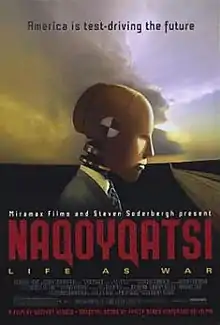Naqoyqatsi
Naqoyqatsi (/nɑːkɔɪˈkɑːtsi/ NAH-koy-KAH-tsee),[4] also known as Naqoyqatsi: Life as War, is a 2002 American film directed by Godfrey Reggio and edited by Jon Kane, with music composed by Philip Glass. It is the third and final film in the Qatsi trilogy.
| Naqoyqatsi | |
|---|---|
 Film poster | |
| Directed by | Godfrey Reggio |
| Produced by | Steven Soderbergh[1] Joe Beirne Godfrey Reggio Lawrence Taub |
| Written by | Godfrey Reggio |
| Music by | Philip Glass |
| Cinematography | Russell Lee Fine |
| Edited by | Jon Kane |
Production company | Qatsi Productions |
| Distributed by | Miramax Films |
Release date |
|
Running time | 89 minutes[3] |
| Country | United States |
| Budget | $3 million |
Naqoyqatsi is a Hopi word (more correctly written naqö̀yqatsi) meaning "life as war". In the film's closing credits, Naqoyqatsi is also translated as "civilized violence" and "a life of killing each other".[4] While Koyaanisqatsi and Powaqqatsi examine modern life in industrial countries and the conflict between encroaching industrialization and traditional ways of life, using slow motion and time-lapse footage of cities and natural landscapes, about eighty percent of Naqoyqatsi uses archive footage and stock images manipulated and processed digitally on non-linear editing (non-sequential) workstations and intercut with specially-produced computer-generated imagery to demonstrate society's transition from a natural environment to a technology-based one. Reggio described the process as "virtual cinema".[5]
Synopsis
According to Reggio, the film has no screenplay per se, but three movements (like those of a symphony) with different themes:[5]
- Numerica.com: Language and place gives way to numerical code and virtual reality.
- Circus maximus: Competition, winning, records, fame, “fair play” and the love of money are elevated to the prime values of life. Life becomes a game.
- Rocketship twentieth century: A world that language can no longer describe. The resulting explosive tempo of technology is war, civilized violence.
Production
The September 11 attacks against the World Trade Center took place very close to the film's production studio, impacting the content of the film and further convincing the crew of the importance of its subject.[5]
Music
The music is more in the traditional orchestral tradition than much of Glass's work as a familiar doorway to images so disconnected from the familiar world. One instrument, the cello played by Yo-Yo Ma, plays through much of the piece. Some unconventional instruments are used in addition to traditional ones, including a didgeridoo and an electronically-created jaw harp.[5]
Soundtrack.net reviewer Glenn McClanan noted that unlike the previous two films, the music is more on the softer side.[6]
Release
The film was released on DVD by Miramax on October 14, 2003.[7][8]
The Criterion Collection released this as part of the Qatsi trilogy on December 11, 2012.[9]
Reception
Rotten Tomatoes reported that 48% out of 52 reviews were positive with the average score of 5.82/10, and the consensus saying that it is "the weakest film in Reggio's trilogy".[10]
See also
- Koyaanisqatsi: Life Out of Balance (1982)
- Chronos (1985)
- Powaqqatsi: Life in Transformation (1988)
- Baraka (1992)
- Samsara (2011)
References
- "Naqoyqatsi Blu-ray" – via www.blu-ray.com.
- "Naqoyqatsi" – via www.flickchart.com.
- "Naqoyqatsi". The Criterion Collection.
- "Naqoyqatsi Definitions". Koyaanisqatsi.org. Institute for Regional Education. Retrieved August 24, 2011.
- Rotten Tomatoes website: Reviews and long article on Naqoyqatsi, with input and quotations from Godfrey Reggio and Philip Glass
- "Naqoyqatsi Soundtrack (2002)". www.soundtrack.net.
- "Naqoyqatsi (2002) - Home Video Reviews - TCM.com". Turner Classic Movies.
- Amazon.com
- "The Qatsi Trilogy (Koyaanisqatsi / Powaqqatsi / Naqoyqatsi) - Criterion Collection (Blu-ray)". DVD Talk.
- "Naqoyqatsi (Naqoyqatsi: Life as War) (2002) - Rotten Tomatoes". Rotten Tomatoes. Retrieved 2013-04-26.
External links
- The Trilogy's Home Page
- Naqoyqatsi at IMDb
- Naqoyqatsi at AllMovie
- The Qatsi Trilogy: Celebration and Warning an essay by Scott MacDonald at the Criterion Collection